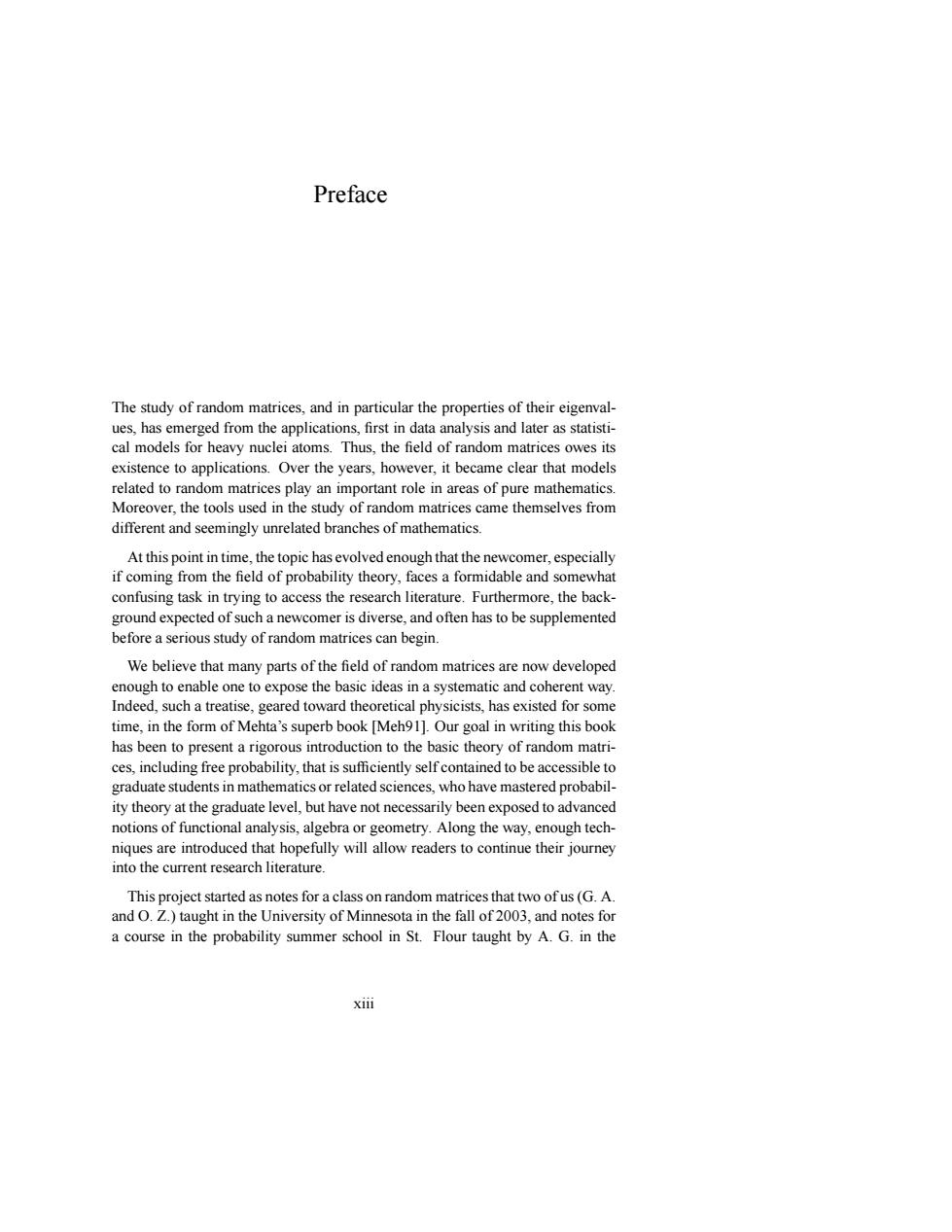正在加载图片...

Preface The study of random matrices,and in particular the properties of their eigenval- ues,has emerged from the applications,first in data analysis and later as statisti- cal models for heavy nuclei atoms.Thus,the field of random matrices owes its existence to applications.Over the years,however,it became clear that models related to random matrices play an important role in areas of pure mathematics. Moreover,the tools used in the study of random matrices came themselves from different and seemingly unrelated branches of mathematics. At this point in time,the topic has evolved enough that the newcomer,especially if coming from the field of probability theory,faces a formidable and somewhat confusing task in trying to access the research literature.Furthermore,the back- ground expected of such a newcomer is diverse,and often has to be supplemented before a serious study of random matrices can begin. We believe that many parts of the field of random matrices are now developed enough to enable one to expose the basic ideas in a systematic and coherent way. Indeed,such a treatise,geared toward theoretical physicists,has existed for some time,in the form of Mehta's superb book [Meh91].Our goal in writing this book has been to present a rigorous introduction to the basic theory of random matri- ces,including free probability,that is sufficiently self contained to be accessible to graduate students in mathematics or related sciences,who have mastered probabil- ity theory at the graduate level,but have not necessarily been exposed to advanced notions of functional analysis,algebra or geometry.Along the way,enough tech- niques are introduced that hopefully will allow readers to continue their journey into the current research literature. This project started as notes for a class on random matrices that two of us(G.A. and O.Z.)taught in the University of Minnesota in the fall of 2003,and notes for a course in the probability summer school in St.Flour taught by A.G.in the xiiiPreface The study of random matrices, and in particular the properties of their eigenvalues, has emerged from the applications, first in data analysis and later as statistical models for heavy nuclei atoms. Thus, the field of random matrices owes its existence to applications. Over the years, however, it became clear that models related to random matrices play an important role in areas of pure mathematics. Moreover, the tools used in the study of random matrices came themselves from different and seemingly unrelated branches of mathematics. At this point in time, the topic has evolved enough that the newcomer, especially if coming from the field of probability theory, faces a formidable and somewhat confusing task in trying to access the research literature. Furthermore, the background expected of such a newcomer is diverse, and often has to be supplemented before a serious study of random matrices can begin. We believe that many parts of the field of random matrices are now developed enough to enable one to expose the basic ideas in a systematic and coherent way. Indeed, such a treatise, geared toward theoretical physicists, has existed for some time, in the form of Mehta’s superb book [Meh91]. Our goal in writing this book has been to present a rigorous introduction to the basic theory of random matrices, including free probability, that is sufficiently self contained to be accessible to graduate students in mathematics or related sciences, who have mastered probability theory at the graduate level, but have not necessarily been exposed to advanced notions of functional analysis, algebra or geometry. Along the way, enough techniques are introduced that hopefully will allow readers to continue their journey into the current research literature. This project started as notes for a class on random matrices that two of us (G. A. and O. Z.) taught in the University of Minnesota in the fall of 2003, and notes for a course in the probability summer school in St. Flour taught by A. G. in the xiii